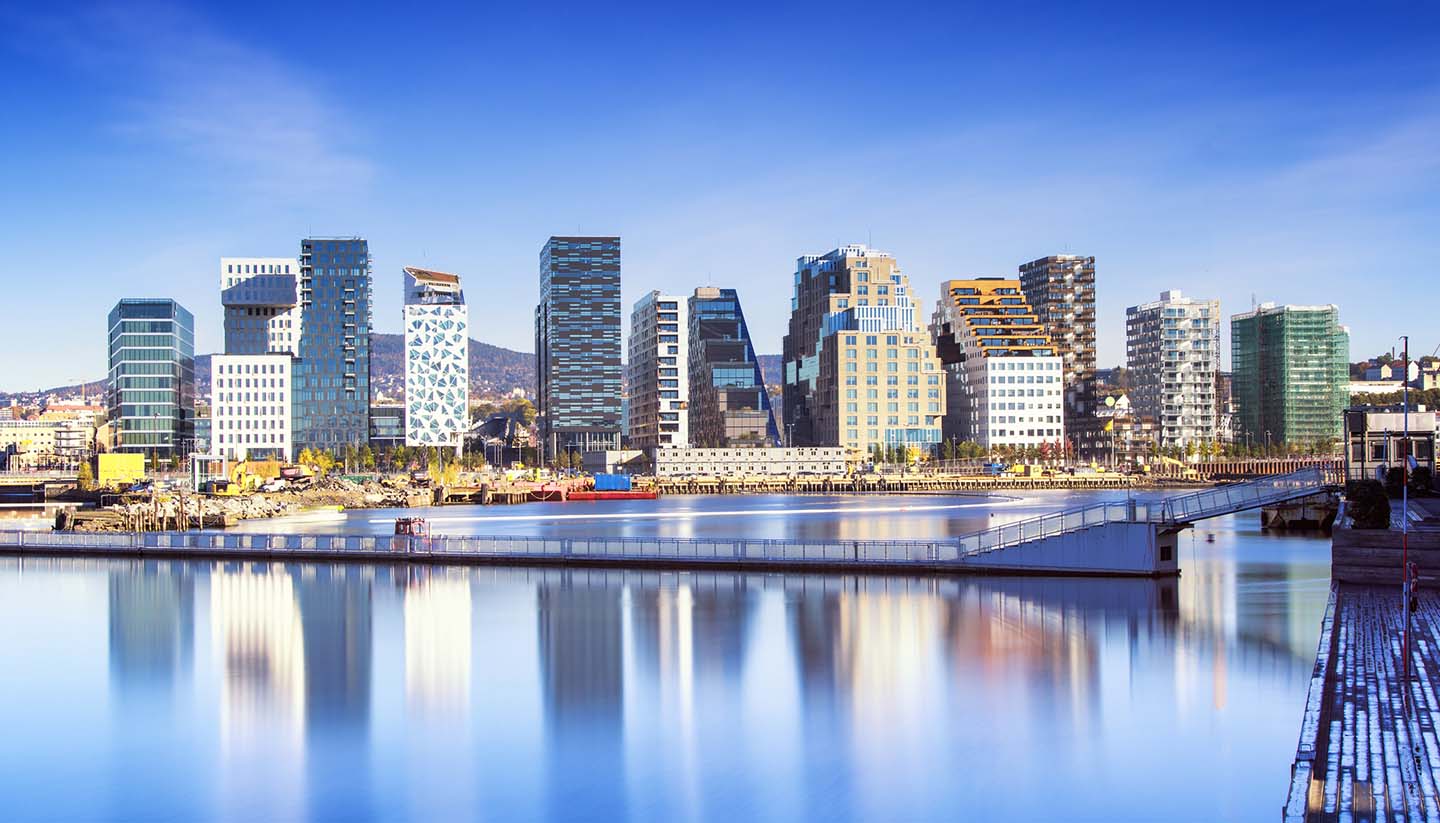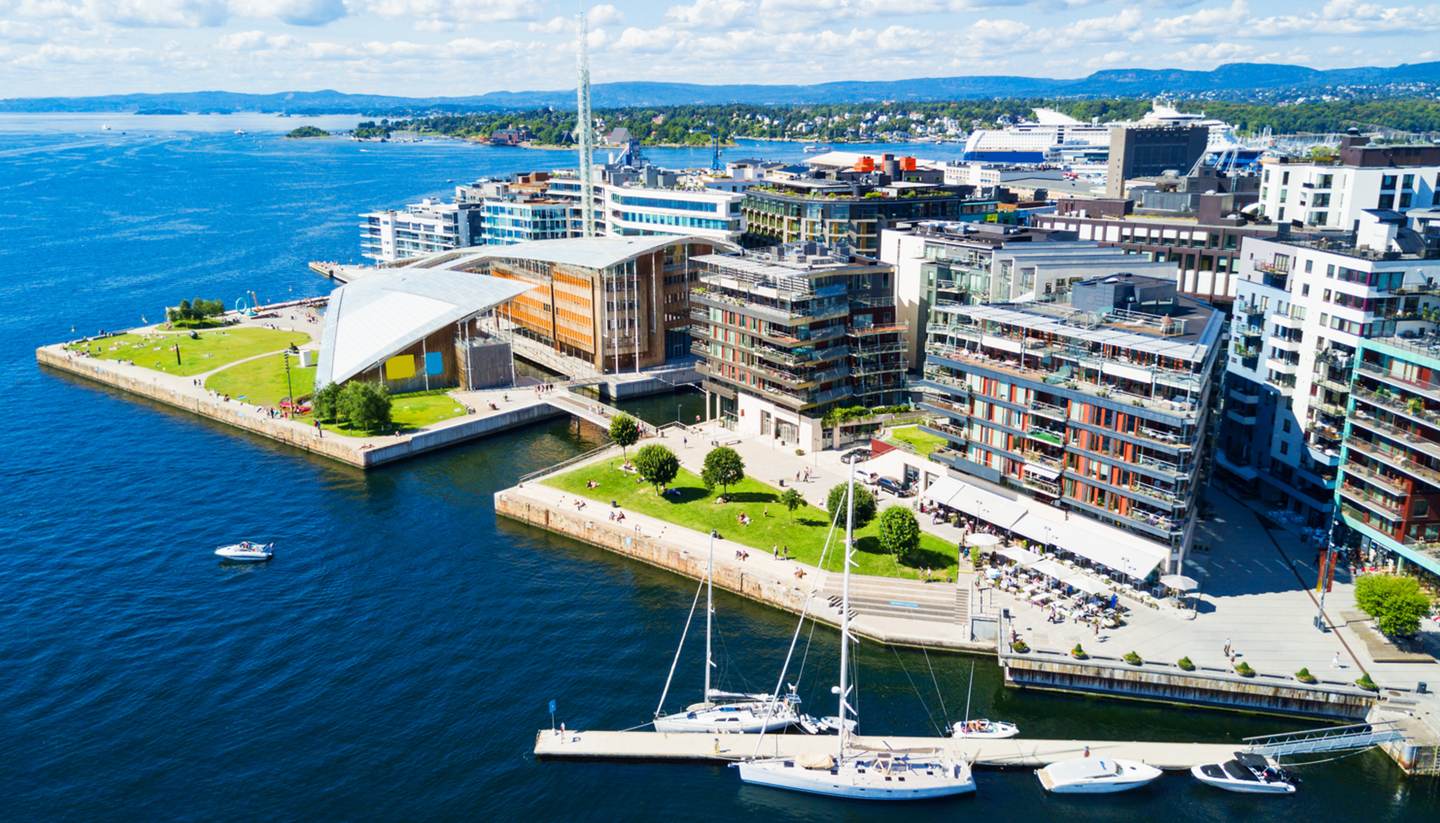Travel to Oslo
Flying to Oslo
Airlines operating direct flights to Oslo from the UK include British Airways, Norwegian, Ryanair and SAS. From the USA, there are direct flights with Norwegian and SAS. Prices are fairly steady year-round, but summer is the most popular time to visit, so book well ahead for cheaper fares in July and August.
Flight times
From London - 2 hours; New York - 7 hours 20 minutes; Los Angeles - 10 hours 15 minutes; Toronto - 9 hours 25 minutes (including stopover); Sydney - 24 hours (including stopover).
Travel by road
Driving conditions in and around Oslo are generally good with well-maintained roads, and some dual carriageways. Elsewhere in Norway, particularly in the mountainous areas, roads are less good and should be used with great care. It is also essential to check that mountain passes are not closed by snow.
Major routes are designated by the European 'E' prefix - for example, the roads from Oslo to Trondheim are the E3 and E6. Other roads take the 'R' (Riksvei) prefix. All roads leading into Oslo have toll booths.
Speed limits on roads outside towns vary between 80 and 100kph (50-60mph). In urban areas, the general speed limit is set at 50kph (30mph), while some residential streets are designated with a 30kph (19mph) limit and are often equipped with unmarked speed-humps - drivers should proceed with care.
Additionally, away from 'priority' routes (designated by yellow diamond signs) drivers should beware of vehicles suddenly pulling out from side turns on the right - they officially have right of way and fault falls on the driver who hits them.
Traffic drives on the right. The minimum age for driving is 18 years and drivers must be in possession of a full national driving licence or an International Driving Permit. You must carry your licence at all times when driving. If bringing a vehicle into Norway, registration documents and a valid certificate of insurance are required. A Green Card, while not compulsory, is desirable. Dipped headlights must be illuminated at all times.
Emergency breakdown services
The Norwegian Automobile Federation (NAF) (tel: 08505, in Norway only; www.naf.no) operates an emergency breakdown service which can be used by anyone who is a member of a major international motoring organisation.
Routes
The main roads into Oslo are the E6, which runs from Sweden in the southeast via Oslo to Lillehammer, Trondheim and the north of Norway; the E16 from Bergen in the west; and the E18 from Stockholm in the east which goes on to Stavanger in the west. The Øresund Bridge between Sweden and Denmark makes it possible for travellers to drive from Norway to Denmark without resorting to a ferry.
Coaches
The bus station, Bussterminalen, Schweigaards gate 10, is located under the Galleriet shopping centre, behind Oslo S station.
Nor-Way Bussekspress (tel: +47 22313150; www.nor-way.no) operates a network of domestic and international long-distance routes and tickets are available at the station or on the bus. Destinations include larger Norwegian towns and European destinations such as Copenhagen, Stockholm, Warsaw, Berlin and Hamburg.
Time to city
From Trondheim - 6 hours 15 minutes; Bergen - 7 hours.
Travel by Rail
Services
Trains to Oslo are generally clean and punctual, although the catering service is minimal. All trains arrive and depart from Oslo S (Oslo Central). Located on Jerbanetorget, the station is easily reachable by local bus from all parts of the city. Local commuter trains operate both from here and the Nationaltheatret T-Bane (underground) station at Karl Johans gate.
The Norges Statsbaner (NSB) is the national rail operator and has routes covering all parts of the country from Oslo. The Bergen Line goes from Oslo to Bergen, along Northern Europe's highest railway and includes the Flåm Railway – Europe’s steepest stretch of track.
The Dovre railway connects Oslo to Trondheim while the Southern Line runs from Oslo to Stavanger along the south coast. The Rauma Railway, made famous by the Harry Potter films, is part of the Dovre route.
Trains connect Oslo with Gothenburg and on to Copenhagen, from where it's possible to continue to London by train via Paris or Brussels. Trains also run direct to Stockholm.
Operators
Norges Statsbaner - NSB (tel: 8150 0888, in Norway only; or +47 61 05 19 10 – press 9 for information in English; ; www.nsb.no) is the national rail provider, operating the local and long-distance services from Oslo.
SJ (tel: +46 771 757 575, in Sweden; www.sj.se), the Swedish national provider, operates routes to and from Gothenburg and Copenhagen via the Øresund Link train.
Journey times
From Bergen - 6 to 7 hours; Stockholm - 5 hours; Copenhagen - 8 hours (including change at Gothenburg).
Travel by boat
Thanks to its fjord location, Oslo enjoys easy access to the sea and the fjord’s numerous islands, including Hovedøya, Lindøya, Nakholmen, Bleikøya, Gressholmen, and Langøyene, all of which are served by Oslo boats from the Western Port. The port authority, Port of Oslo (tel: +45 21 80 21 80; www.oslohavn.no), operates in both of the city’s two main ports – Western and Southern.
Ferries dock at the Western Port Vippetangen, Revierkaia, Filipstad and Hjortnes quays, and cruise ships stop at Akershus, Vippetangen and Revierkaia. All quays are within walking distance of the city centre and offer Wi-Fi access.
Ferry operators
Regular ferry services run to and from Kiel, Fredrikshavn and Copenhagen, as well as to the many islands that dot the Oslofjord.
DFDS Seaways (tel: +47 2162 1340; www.dfdsseaways.com) is the main operator for ferries to Copenhagen.
Color Line Ferries (tel: +47 22 94 42 00; www.colorline.no) runs to Kiel in Germany.
Stena Line (tel: +47 02010; www.stenaline.com) operates the Oslo to Fredrikshavn route.
Transfer
Bus 60 stops a few minutes’ walk from the Vippetangen Quay, while Hjortnes is a short distance from tramlines 10 and 13 which originate at Oslo S. Color Line passengers can take advantage of a dedicated bus, which leaves Oslo S one hour before the ferry departs.



